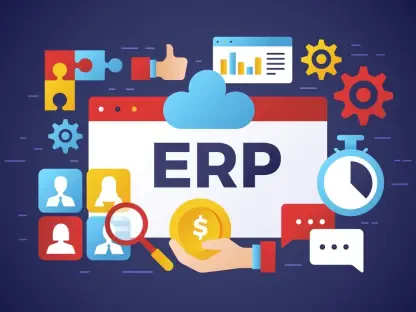In an era where digital innovation dictates the pace of business, the financial services industry stands at a critical juncture, grappling with the need to modernize while managing complex regulatory demands. Imagine a world where transactions are seamless, embedded directly into the software ecosystems businesses use daily, slashing operational delays by half. This is no longer a distant vision but a tangible reality fueled by Software as a Service (SaaS) solutions. The rapid adoption of cloud-based platforms has begun to redefine how financial institutions operate, offering unprecedented flexibility and efficiency. This report delves into the transformative power of SaaS, with a particular focus on contributions from industry leaders like FIS, exploring how these advancements are reshaping payments, banking tools, and fund processing for a more agile future.
The Current Landscape of Financial Services and SaaS Integration
The financial services sector is undergoing a profound digital transformation, driven by the urgent need to adapt to evolving customer expectations and technological breakthroughs. Traditional institutions, once reliant on cumbersome, on-premises systems, are increasingly turning to SaaS models to streamline operations across key areas such as payments, banking tools, and fund processing. This shift is not merely a trend but a strategic necessity, as businesses demand real-time solutions that can scale with growth and integrate seamlessly with existing workflows.
Major players like FIS are leading the charge, providing innovative SaaS platforms that address the unique challenges of the industry. The move away from isolated, standalone software to cloud-based, integrated systems marks a significant evolution, enabling firms to respond swiftly to market changes and regulatory requirements. Unlike older models that required extensive manual updates, SaaS offers automated scalability, reducing downtime and operational costs for institutions handling high-volume transactions.
This transition holds immense significance for modern business demands, particularly in a landscape where speed and adaptability are paramount. Cloud-based solutions facilitate collaboration across global teams, ensuring that financial services providers can offer consistent, reliable experiences to clients. As digital transformation accelerates, the integration of SaaS is proving to be a cornerstone for staying competitive in an increasingly interconnected economy.
Key Trends and Innovations in SaaS for Financial Services
Emerging Technologies and Embedded Payments
One of the most striking trends in financial services is the rise of embedded payments, where transaction capabilities are integrated directly into software ecosystems through API-driven models. This approach enhances flexibility, allowing businesses to process payments without relying on external systems, thereby boosting efficiency. It also opens new avenues for profitability, as companies can monetize services by embedding financial tools tailored to specific user needs.
A prime example of this innovation is FIS’s transformation of the Private Capital Suite into a cloud-native SaaS solution. This platform supports intricate fund processing and compliance requirements, leveraging scalable APIs to manage complex workflows with ease. Such advancements demonstrate how SaaS can simplify even the most regulated and detailed financial operations, providing a blueprint for other firms seeking to modernize.
Embedded payments are not just about functionality; they also create significant revenue streams through service monetization. By integrating financial tools directly into platforms, companies can offer value-added services that meet market demands swiftly. This capability ensures that financial service providers remain agile, adapting to consumer expectations without the lag associated with traditional system overhauls.
Market Growth and Future Projections
The adoption of SaaS in financial services continues to surge, driven by its inherent scalability and adaptability benefits. Institutions leveraging these solutions report marked improvements in operational efficiency, with some achieving up to 30% faster processing times for transactions and data management. This growth is evident across diverse segments, from small fintech startups to established banking giants, all recognizing the value of cloud-based agility.
Looking ahead, SaaS-driven solutions are poised to fundamentally reshape operational models within the industry. Projections indicate that over the next few years, from 2025 to 2027, the reliance on SaaS will intensify, with an expected increase in adoption rates as firms prioritize digital infrastructure investments. This momentum suggests a future where integrated platforms become the norm, replacing fragmented systems with cohesive, user-centric tools.
Performance indicators further underscore the potential for expansion, with many organizations citing enhanced revenue opportunities through SaaS-enabled services. The ability to scale operations without significant capital expenditure is a key driver, as is the capacity to deliver personalized customer experiences. These factors collectively point to a robust trajectory for SaaS, positioning it as a critical enabler of long-term growth in financial services.
Challenges in Adopting SaaS within Financial Services
Despite the clear advantages, integrating SaaS into financial services is not without hurdles, with data security risks topping the list of concerns. The shift to cloud environments exposes sensitive information to potential breaches, especially in an industry where trust is paramount. Additionally, compatibility issues with existing legacy systems often complicate the transition, leading to delays and unexpected costs.
To address these obstacles, robust security frameworks and strategic planning are essential. Financial institutions must invest in comprehensive cybersecurity measures, such as encryption and multi-factor authentication, to safeguard data during migration and beyond. Simultaneously, phased implementation plans can help mitigate compatibility challenges, ensuring that new SaaS platforms integrate smoothly with older infrastructure without disrupting critical operations.
Balancing innovation with reliability remains a crucial consideration in this highly regulated sector. While the allure of cutting-edge technology drives adoption, maintaining consistent service delivery is vital to preserving client confidence. Firms must prioritize thorough testing and contingency planning to minimize risks, ensuring that the pursuit of modernity does not compromise the stability that underpins financial trust.
Regulatory and Security Considerations in SaaS Adoption
The regulatory landscape for SaaS in financial services is intricate, with stringent compliance requirements dictating how data is handled and stored. Standards such as GDPR and local financial regulations impose strict guidelines on cloud-based systems, necessitating meticulous oversight to avoid penalties. This environment underscores the importance of aligning SaaS implementations with legal mandates to protect both institutions and their clients.
Initiatives like the Cloud Security Alliance’s SaaS Security Capability Framework, which includes 41 specific security controls, represent a significant step toward building trust and consistency in SaaS evaluations. This framework provides a structured approach to assessing and mitigating risks, offering financial firms a reliable benchmark for securing cloud solutions. Such efforts are critical in fostering confidence among stakeholders wary of digital vulnerabilities.
Security measures play a pivotal role in regulated environments, directly influencing industry practices and the broader adoption of SaaS. Beyond compliance, robust protocols help safeguard against cyber threats, ensuring that sensitive financial data remains protected. As these practices evolve, they are likely to encourage more institutions to embrace SaaS, knowing that safety mechanisms are in place to support their digital journey.
The Future of Financial Services with SaaS and FIS Solutions
Looking toward the horizon, SaaS is set to drive the creation of comprehensive finance platforms that integrate seamless user interfaces directly into operational systems. This evolution promises to simplify complex processes, enabling businesses to manage payments, investments, and compliance from a single, intuitive dashboard. Industry leaders like FIS are already paving the way with solutions that prioritize accessibility and functionality for diverse user bases.
Emerging trends point to business model innovation, performance optimization, and trust as key differentiators for SaaS adopters. Partnerships, such as Mastercard’s collaboration with Unipaas or Wix’s development of integrated financial suites for small businesses, highlight the power of strategic alliances in expanding service offerings. These collaborations reduce operational friction, allowing firms to deliver enhanced value while maintaining competitive edges.
Adaptability, bolstered by strong security protocols, will shape the next generation of financial services. The ability to pivot quickly in response to market shifts, coupled with unwavering data protection, positions SaaS as a cornerstone of future-ready strategies. As these elements converge, the industry is likely to witness a wave of transformation, with integrated, secure platforms becoming the standard for financial innovation.
Conclusion: The SaaS Revolution in Financial Services
Reflecting on the journey of SaaS in financial services, it has become evident that its integration marks a turning point for the industry, driven by pioneering solutions from FIS and the rise of embedded payments. Strategic collaborations have proven instrumental, weaving together technology and trust to redefine operational paradigms. The emphasis on security frameworks stands out as a critical enabler, addressing vulnerabilities that once hindered cloud adoption.
For financial firms aiming to sustain momentum, the next steps involve prioritizing seamless integration of SaaS platforms while fortifying defenses against emerging cyber threats. Investing in partnerships offers a pathway to innovation, allowing institutions to tap into specialized expertise and expand their reach. By aligning with regulatory standards and fostering adaptability, companies can position themselves at the forefront of a digitally empowered landscape.
Beyond immediate actions, a broader consideration emerges around cultivating a culture of continuous improvement. Financial entities need to embrace ongoing training and system upgrades to keep pace with technological advancements. By viewing SaaS not just as a tool but as a strategic asset, the sector can unlock enduring growth, ensuring resilience in an ever-evolving global market.









